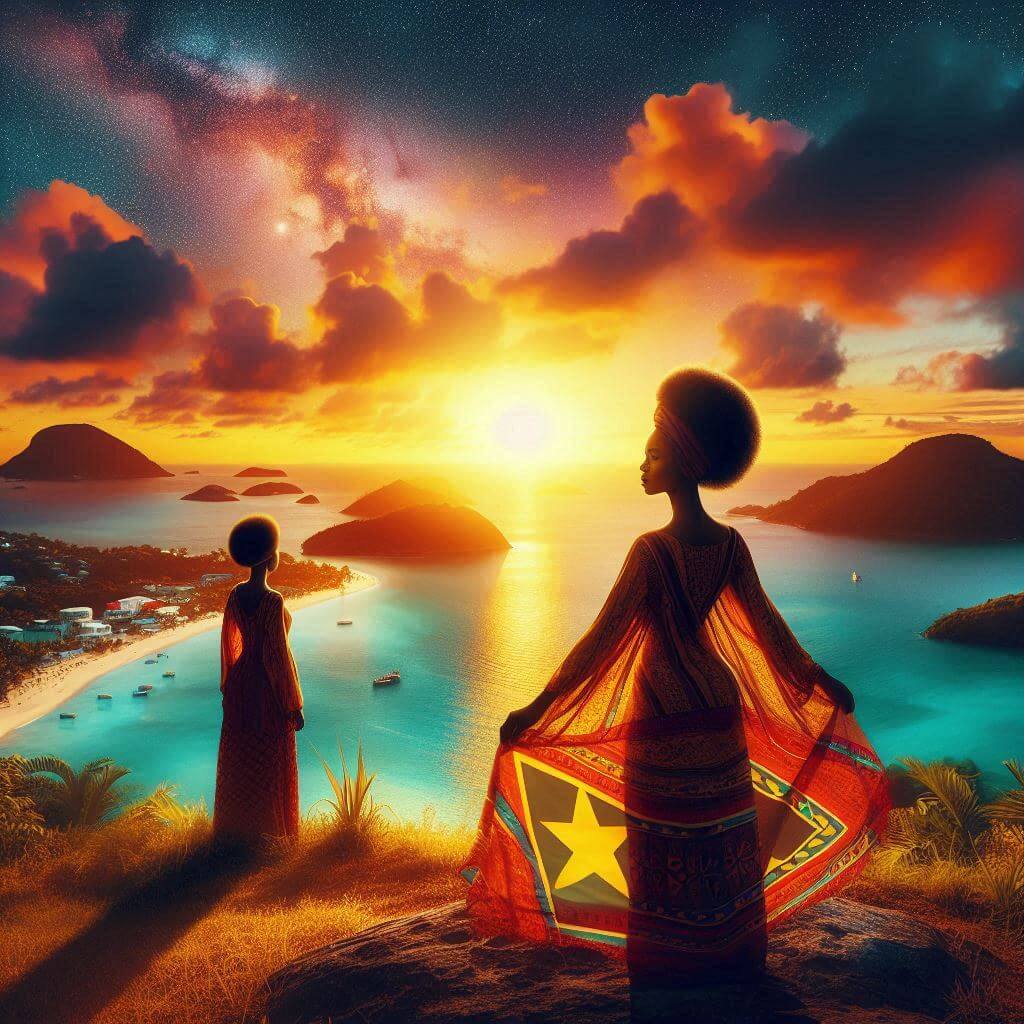The flag of Antigua and Barbuda is a vibrant and symbolic representation of the nation's history, culture, and aspirations. It features a striking red field with an inverted isosceles triangle in its center. Within this triangle are three horizontal bands: black at the top, ultramarine blue in the middle, and white at the bottom. The triangle is crowned by a half sun rising from the blue band, with seven points. This unique design encapsulates the essence of the twin-island nation, its natural beauty, and the spirit of its people.
Antigua and Barbuda information
| National Flag Day | — |
| Sovereign state | Yes |
| Official name | Antigua and Barbuda |
| Capital | St. John's |
| Population | 97,929 |
| Area | 442 km² |
| Currency | East Caribbean dollar (XCD) |
| Language | English |
| Continent | North America |
| Region | Caribbean |
| Subregion | — |
| Borders | — |
| Timezone | Atlantic Standard Time (AST) UTC-4 |
| Calling code | +1-268 |
| Top-level domain | .ag |
History and Evolution of the Antigua and Barbuda Flag
 The current flag of Antigua and Barbuda was officially adopted on February 27, 1967, coinciding with the country's achievement of associated statehood within the British Commonwealth. It was designed by Sir Reginald Samuel, a local artist and teacher, who won a national competition to create a flag that would symbolize the nation's identity and aspirations.
The current flag of Antigua and Barbuda was officially adopted on February 27, 1967, coinciding with the country's achievement of associated statehood within the British Commonwealth. It was designed by Sir Reginald Samuel, a local artist and teacher, who won a national competition to create a flag that would symbolize the nation's identity and aspirations.
Prior to 1967, Antigua and Barbuda, as a British colony, used the British Blue Ensign defaced with the colonial badge of Antigua. This earlier flag featured a landscape scene with a sugar mill, symbolizing the islands' colonial economy. The transition to the current flag marked a significant shift, moving away from colonial symbolism to a design that celebrated the islands' natural beauty and the hopes of its people.
Although the flag was adopted in 1967, it continued to represent Antigua and Barbuda through its full independence from the United Kingdom on November 1, 1981. The decision to retain the flag post-independence reflects the enduring nature of its symbolism and its strong resonance with the Antiguan and Barbudan people.
Symbolism and Design of the Antigua and Barbuda Flag
Every element of the Antigua and Barbuda flag is imbued with deep symbolism, reflecting the nation's geography, history, and aspirations:
- The red field symbolizes the energy and dynamism of the people. It also represents the blood shed by the ancestors in their struggle against slavery and colonialism.
- The inverted triangle has multiple meanings:
- It represents the numerous bays and natural harbors of the islands.
- Its shape mimics the letter "A", standing for Antigua.
- The inverted triangle is also seen as a symbol of equality and stability.
- The black band at the top of the triangle symbolizes the African heritage of the majority of the population and the rich, fertile soil of the islands.
- The blue band in the middle represents hope and the Caribbean Sea surrounding the islands.
- The white band at the bottom symbolizes the sandy beaches that make Antigua and Barbuda famous as a tourist destination. It also represents purity and clarity of purpose.
- The rising sun with seven points symbolizes:
- The dawn of a new era for the nation.
- The seven points represent the six parishes of Antigua and Barbuda as the seventh.
- It also alludes to the country's nickname as the "Land of 365 Beaches" - one for each day of the year.
Usage and Significance of the Antigua and Barbuda Flag
 The flag of Antigua and Barbuda serves as a powerful symbol of national identity and pride. It is prominently displayed on government buildings, schools, and public institutions across both islands. During national holidays, such as Independence Day (November 1) and National Heroes Day (December 9), the flag takes center stage in celebrations, parades, and official ceremonies.
The flag of Antigua and Barbuda serves as a powerful symbol of national identity and pride. It is prominently displayed on government buildings, schools, and public institutions across both islands. During national holidays, such as Independence Day (November 1) and National Heroes Day (December 9), the flag takes center stage in celebrations, parades, and official ceremonies.
In international contexts, the Antigua and Barbuda flag represents the nation at diplomatic events, United Nations gatherings, and sporting competitions. It's a source of pride for Antiguan and Barbudan athletes competing in events like the Olympic Games and Cricket World Cup, where it symbolizes their national identity on the global stage.
The flag also plays a significant role in the country's tourism industry, often featured in promotional materials as a symbol of the nation's warm hospitality and stunning natural beauty. Many visitors to Antigua and Barbuda purchase miniature versions of the flag as souvenirs, further spreading awareness of the country's distinct cultural heritage.
Interesting Facts About the Antigua and Barbuda Flag
- The designer of the flag, Sir Reginald Samuel, was awarded the Grand Cross of the Most Princely Order of Merit (GCPM) for his contribution to the national symbols of Antigua and Barbuda.
- The flag's unique design, particularly the inverted triangle, makes it easily recognizable among world flags.
- The seven-pointed sun on the flag is sometimes referred to as the "Antigua Star" and has become a popular symbol in local art and culture.
- The exact shade of blue used in the flag is ultramarine, chosen for its vibrancy and its representation of the Caribbean Sea.
- In Antiguan and Barbudan culture, the rising sun on the flag is often interpreted as a symbol of resilience and the ability to overcome challenges.
- The flag is featured prominently in the country's coat of arms, where it is held by two deer, symbolizing the wildlife of the islands.